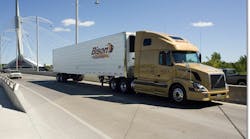The annual Best Fleets to Drive For survey and contest, produced by CarriersEdge in partnership with the Truckload Carriers Association, evaluates fleets across a range of performance criteria, identifying the companies having the most success with its drivers. The program evaluates more than 100 nominated fleets and collects thousands of driver surveys each year. The resulting data provides a clear picture of what’s working at fleets of all sizes.
The evaluation process is difficult, requiring data to be collected from all departments and surveys from a healthy number of drivers. Fleets that make our Top 20 list have really figured out the recipe for success.
This is our 10th year with the program, so we’ve seen trends, and new programs put in place, which helps companies make stronger connections with drivers. This year, it was no different. Best Fleets once again demonstrated a range of creative programs across all categories, but one common theme was a focus on bringing people together to improve efficiency across the company. While drivers often see themselves as something akin to an outside vendor -- providing services to a company they’re only loosely affiliated with – Best Fleets are finding ways to bring drivers into the fold. The result is drivers who feel a deeper connection with the company. This has created improved retention rates as well as operational efficiency. Here are some ways they’re doing that:
Getting driver input
Best Fleets have always distinguished themselves by the way they seek input from drivers, and this year they found new ways to do that. In addition to regularly conducting formal surveys to gather driver feedback, Best Fleets use informal tools to gather opinions on various issues within the company. Common options include short online surveys (for example three to five poll questions through services such as SurveyMonkey or ConstantContact), informal town hall or breakfast meetings, and expectation exchanges during the onboarding process.
When it comes to performance reviews, Bison Transport, this year’s overall winner in the large fleet category, uses a motivational interviewing technique. Instead of focusing purely on hard numbers and operational stats, this technique probes the feelings and motivations behind the work, helping to uncover opportunities for improvement that are often below the surface.
Some fleets have expanded the traditional annual performance review to now have drivers provide a review of the company -- offering them a chance to turn the tables and weigh in on what’s going well and what could stand to be improved.
Continuing to grow in popularity is Facebook, now regularly used as a kind of virtual water cooler for fleets. While Facebook has been the subject of controversy recently, there’s no denying the fact that it provides a useful platform for connecting with drivers and collecting ideas. With more than 77 percent of drivers reporting they use it regularly, it’s a valuable tool for fleets simply because it’s where the drivers already are. Some common uses of Facebook include:
- Creating private groups for drivers to discuss company business, and separate groups for drivers’ families to share ideas and information as well;
- Using Facebook Live to stream meetings and other company events, keeping drivers in the loop even when they can’t be there in person;
- Conducting informal polls and group discussions about upcoming events and company activities.
Getting on the same page
Ensuring message consistency across the company is a challenge that all businesses face, and this year’s Best Fleets are finding a variety of ways to tackle that challenge. One of the simplest solutions, employed by a number of this year’s Top 20, is to have interdepartmental meetings and multi-disciplinary teams. Rather than having an ops meeting that only includes ops people, or a maintenance meeting exclusively for shop staff, these fleets are bringing the groups together, inviting ops and maintenance to discuss issues at driver services meetings, and vice versa. The result is a better understanding of each department’s needs and challenges, and fewer mixed messages for drivers.
Building on the idea of cross-pollination, more and more fleets are implementing formal cross-training programs so that all departments have a clear grasp of what goes on elsewhere in the company. Sales, maintenance, finance, ops, safety – they all have something to learn from the other, and these fleets are formalizing that so everyone continues to build their knowledge of the broader business issues.
Having office staff understand each other is great, but to truly make drivers part of the team, they need to be included in this as well. This year’s Top 20 are making that happen by having drivers spend dedicated time in each department as part of orientation, then continuing that with job shadowing programs later on.
That intermingling of departments provides both drivers and office staff with a deeper appreciation of what life is like for the other, eliminating many issues that arise primarily from misunderstanding other departmental functions.
Changing the dynamic
Traditionally, many fleets have kept office staff in one place and drivers in another. This year’s Best Fleets have been changing that dynamic by quite literally tearing down the walls that separate departments. Open plan offices continue to grow in popularity, offering drivers easy access to anyone they may need (or want) to interact with. Restructuring of floor plans also creates more opportunities for random meetings and hallway interactions that often lead to breakthrough ideas.
Another way that this year’s Best Fleets have changed the office dynamic is to focus staff development programs on things that help drivers directly. While all fleets evaluated through the 2018 edition of the program offer a range of performance improvement and career development opportunities for office staff and management, not all are focused on things that directly help drivers. However, fully 65 percent of the Top 20 have programs aimed squarely at helping office staff improve the experience for drivers. Common examples include:
- Training on personality types and communication styles, so office staff can understand driver preferences and serve them better;
- 360-degree reviews and management scorecards, offering drivers a chance to provide feedback on their office counterparts directly;
- Customer Service training programs focused on serving internal customers (e.g. drivers).
Perhaps the most creative program to change the dynamic of the office is a non-specific hiring program employed by some of this year’s Top 20. In the program, new hires from outside the industry (often younger, Millennial workers) are hired by the company, but not for a specific position. The new hires rotate through several positions in the company (that they’re eligible or qualified for) for the first few weeks, then choose the one they feel is the best fit. It’s a creative approach to hiring that looks to have a promising future.
While the trucking industry continues to have substantial challenges hiring and retaining skilled workers, this year’s Best Fleets to Drive For demonstrate that the industry also has more than enough creativity and resourcefulness to overcome those challenges for the long term.




